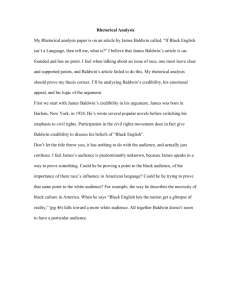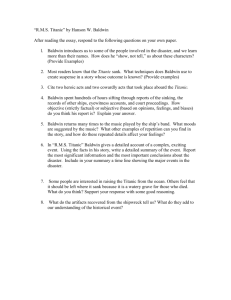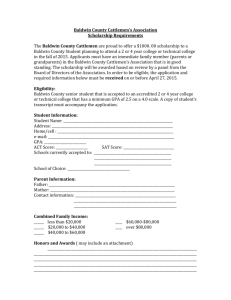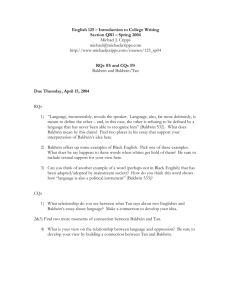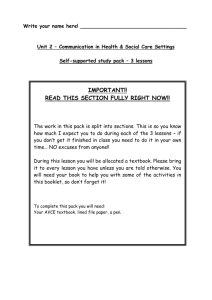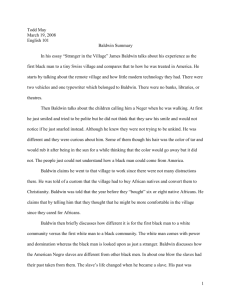James Baldwin's Democracy…and Ours By Lawrie Balfour
advertisement
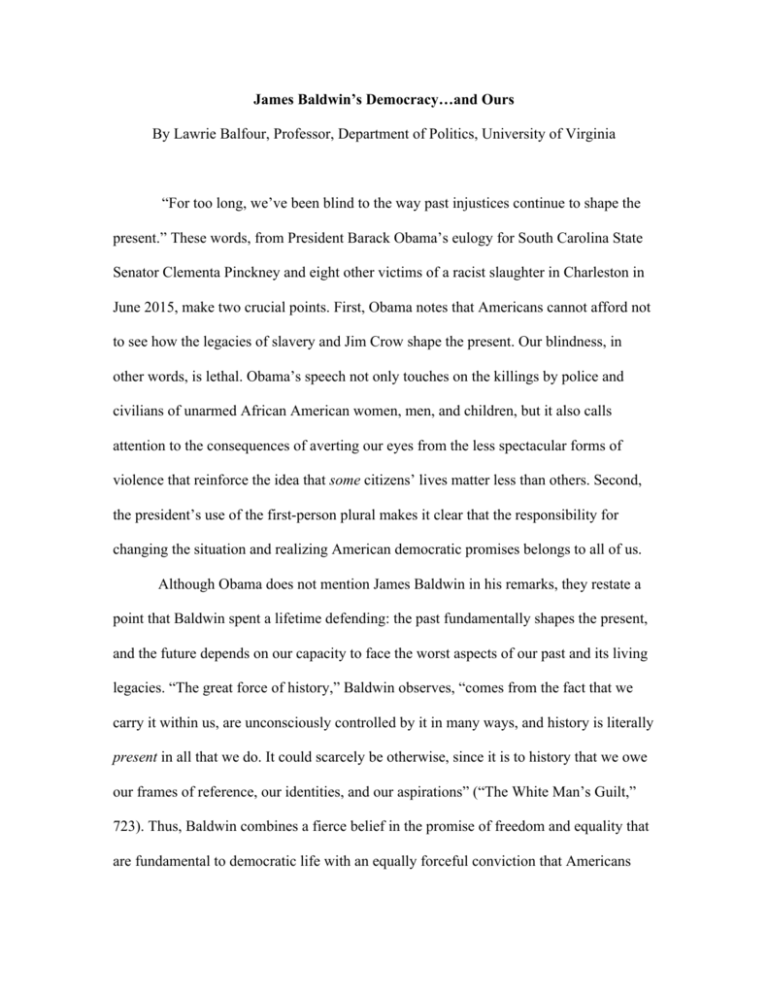
James Baldwin’s Democracy…and Ours By Lawrie Balfour, Professor, Department of Politics, University of Virginia “For too long, we’ve been blind to the way past injustices continue to shape the present.” These words, from President Barack Obama’s eulogy for South Carolina State Senator Clementa Pinckney and eight other victims of a racist slaughter in Charleston in June 2015, make two crucial points. First, Obama notes that Americans cannot afford not to see how the legacies of slavery and Jim Crow shape the present. Our blindness, in other words, is lethal. Obama’s speech not only touches on the killings by police and civilians of unarmed African American women, men, and children, but it also calls attention to the consequences of averting our eyes from the less spectacular forms of violence that reinforce the idea that some citizens’ lives matter less than others. Second, the president’s use of the first-person plural makes it clear that the responsibility for changing the situation and realizing American democratic promises belongs to all of us. Although Obama does not mention James Baldwin in his remarks, they restate a point that Baldwin spent a lifetime defending: the past fundamentally shapes the present, and the future depends on our capacity to face the worst aspects of our past and its living legacies. “The great force of history,” Baldwin observes, “comes from the fact that we carry it within us, are unconsciously controlled by it in many ways, and history is literally present in all that we do. It could scarcely be otherwise, since it is to history that we owe our frames of reference, our identities, and our aspirations” (“The White Man’s Guilt,” 723). Thus, Baldwin combines a fierce belief in the promise of freedom and equality that are fundamental to democratic life with an equally forceful conviction that Americans will not begin to realize those promises until we come to terms with the long story of slavery, segregation, native genocide, and empire of which we are a part. It is telling that so many journalists and social critics have returned to Baldwin’s writing in recent years. They have mined his analysis and borrowed his remarkable phrasing to understand the sources and consequences of police brutality, to account for the terrible expense of being poor, to investigate the endurance of residential segregation and assess its damage, to challenge prevailing ideas about whiteness and blackness, and much more. In a National Public Radio segment on the 2014 uprisings in Ferguson, Missouri, a commentator captured the living force of Baldwin’s writing, when she noted that it “is more relevant than ever.” Baldwin was born in Harlem in 1924. Like many of his neighbors, he was a child of the Great Migration; like all of them, he understood that segregation was as much a fact of life in the North as it was in the Jim Crow South. His mother, Emma Berdis Jones, and his stepfather, David Baldwin, moved north from Maryland and Louisiana, respectively, only to be confined to crumbling neighborhoods and shut out from decent jobs. James, who never knew his biological father, grew up with his parents, a grandmother born in slavery, and eight younger children in a severely religious and economically precarious household. After attempting to escape the streets by making a place for himself in the pulpit as a teen-aged preacher, Baldwin left the church and followed his calling to be a writer. He moved first to Greenwich Village and then to Paris in 1948. For the rest of his life, until he died of cancer in the South of France in 1987, Baldwin was continually on the move, seeking havens where he could do his work. 2 Despite the demands of an itinerary that included stints in France, Switzerland, and Turkey, as well as frequent periods in the United States, Baldwin published six novels, two plays, a screenplay, a children’s book, poetry, and dozens of essays of cultural and political criticism. Even as he sought relief from the pressure of the everyday racial injustice he encountered at home, Baldwin never lost his connection to the United States. As he notes, he could not have done so, even if he had tried. Throughout his life, he used his talents to reflect on contentious political questions and to bring to the surface matters that had been buried or ignored. He was an active participant in the Civil Rights Movement and, at different moments, aligned his voice with Martin Luther King, Jr., Malcolm X, the young women and men of the Student Nonviolent Coordinating Committee, Stokely Carmichael, and Angela Davis. Defying the scorn of younger militants, who were critical of his homosexuality, and the dismissal of literary critics, who contended that his writing lost its subtlety as the 1960s wore on, Baldwin remained a stalwart voice of the radical aspirations of that movement until his death. If Baldwin’s critical fortunes soared and fell over his 40-year career, the power and urgency of his words remain undiminished. Returning to them today offers a way to gauge what has changed, which elements of the past have been reinvented, and what remains the same. To that end, this essay explores four themes that are drawn from Baldwin’s remarkable pair of open letters, which were published together as The Fire Next Time (1963) and that reflect his lifelong creative engagement with his fellow citizens: the uses of the past; the danger of innocence; the difficulty of realizing equality and freedom; and the urgency of addressing injustice now. 3 I. “How Can the American Negro Past Be Used?” It may seem odd, or just wrong, to claim that Americans are reluctant to face history. After all, our enthusiasm for museums and monuments and reenactments suggests that we may be, if anything, too preoccupied with our collective past. Recent years have also witnessed an expansion of that historical sensibility, a move toward more democratic memories with the belated inclusion of unsung heroes and victims of American society in national narratives. Official apologies, reparations, and memorials to enslaved workers, Japanese Americans interned during World War II, and indigenous peoples, as well as initiatives like the construction of the National Museum of African American History and Culture, indicate how our understanding of history has evolved. Yet Baldwin reminds readers that owning our history means not only grappling with the past but also asking to what degree the crimes that we now discredit still shape the contours of our present. His words resonate with particular force today, in the face of claims that Obama’s election ushered in a “post-racial” era. Often, arguments about racial injustice are met with incredulity: Are we still talking about race in the 21st century? And African Americans are expected simply to “get over it” or to admit that “the past is passed.” The difficulty, as Baldwin demonstrates, is that Americans’ desire for closure is premised on selective memory and mythology. He recounts his own attraction to these myths when he remembers watching Westerns as a child and realizing that “it comes as a great shock to see Gary Cooper killing off the Indians, and, although you are rooting for Gary Cooper, that the Indians are you” (“The American Dream and the American Negro,” 714-715). 4 When he defends a fuller accounting of U.S. history, Baldwin particularly invites readers to consider what we can learn from “the American Negro past.” On the one hand, that past is marked by “rope, fire, torture, castration, infanticide, rape; death and humiliation; fear by day and night as deep as the marrow of the bone” (The Fire Next Time, 342). On the other hand, he notes, “this past, this endless struggle to achieve and reveal and confirm a human identity, human authority, yet contains, for all its horror, something very beautiful” (The Fire Next Time, 343). Baldwin finds that beauty in the examples of children who confronted mobs to integrate schools, in women and men who built the railroads and picked the cotton that created American wealth for little or no pay, and in the rich cultural traditions through which African Americans have affirmed their human worth and even found freedom in the hostile country that is theirs. Baldwin would likely not be surprised by the heat of contemporary debates about the Confederate battle flag or about renaming the Washington Redskins. Neither would he diminish their importance. Although these arguments should not eclipse policy debates about education or health care, housing or voting rights, Baldwin understands that battles over language and symbols are real battles. His job, as he sees it, is not simply to expose Americans’ attachments to emblems of a violent past, but also to explore the assumptions and beliefs that sustain those attachments and to challenge our reluctance to reexamine our heritage. II. “It is the Innocence which Constitutes the Crime” This kind of reexamination requires coming to terms with what Baldwin calls “innocence.” For Baldwin, the confinement of so many African Americans to poor 5 schools, unsafe living spaces, and prisons and jails demonstrates a collective unwillingness to acknowledge black humanity. When he uses the language of innocence, Baldwin attacks a kind of willful blindness, a failure of responsiveness to the suffering around us. While Baldwin’s account of innocence most often focuses on the damage done when we insulate ourselves from responsibility for racial injustice or take refuge in the explanatory power of racial categories, it does not stop there. He also troubles rigid lines between acceptable and despised sexualities, both through his frankness about his own sexual orientation and in his courageous decision to risk his literary reputation by publishing his second novel, Giovanni’s Room (1955), which explores American innocence through a homosexual relationship between a white American man and his Italian lover. No matter how deeply we think we believe in democratic ideals, Baldwin writes, real commitment requires grappling with the regularity with which they are violated. His writing models an alternative worldview, which takes as its frame of reference the vantage of the people Toni Morrison calls “the disremembered and unaccounted for.” Although Baldwin lived through an era when public expressions of antiblack racism were far more commonplace than they are today, he insisted that the innocence of avowed liberals could be more destructive than the open racism of figures like Alabama Governor George Wallace or Birmingham’s Bull Connor. In this regard, Baldwin’s assessment of the price of innocence resonates with King’s challenge to “white moderates” and his worries about the damage wrought by “people of good will” who are unwilling to stand up for change. Baldwin’s critical gaze is particularly sharp when he dissects the innocence intrinsic to whiteness. This is not an attack on all white people. 6 Rather, to be white in Baldwin’s sense is to believe that one’s advantages are the product of individual effort and, consequently, to assume that someone else’s misery is simply proof of a lack of initiative. Thus, Baldwin deconstructs mythologies of rugged individualism that fail to recognize our dependence on others and formulation of the American Dream that paper over the role of slavery and exploited labor in producing material benefits for some Americans at the expense of others. Perhaps the clearest evidence of the costs of innocence, in Baldwin’s view, is the condition of American cities. Baldwin dedicates particular attention to Harlem. From his first novel and his earliest essays through the end of his career, he makes the most of the distinction between the “renowned and elegant Fifth,” the home of museums and department stores, and the “wide, filthy, hostile Fifth Avenue” of Harlem (“Fifth Avenue, Uptown,” 170-171); and he details the wreckage that this distinction produces. When he writes that “to smash something is the ghetto's chronic need” (“Notes of a Native Son,” 82), Baldwin presses readers to consider how the ghetto has been constructed to assure the safety of New Yorkers who will never have to live there. And his critique might easily be extended to Baltimore or St. Louis or Detroit or New Orleans or any of the urban areas whose devastation has, briefly, captured national attention. Dwelling on small details that crystallize life in the tenements and churches and streets of America’s poorest urban neighborhoods, Baldwin vivifies what Morrison calls the “interior life” of the children, men, and women confined to a world apart. He conveys the complexity of lives that are effaced by statistics and disregarded by more affluent citizens. The self-deception through which so many Americans manage not to see the plight of their neighbors generates a tremendous amount of anxiety about race, Baldwin 7 notes. Yet he is emphatically not interested in anyone’s guilt. His aim is to provoke readers into doing something to change their circumstances, not to seek his absolution or to wallow in bad feelings. In fact, one of Baldwin’s most effective rhetorical tools is the use of the first-person plural, his willingness to implicate himself in the necessity of struggle. Looking back at the streets of his childhood, for example, he remarks: “It is a terrible, an inexorable, law that one cannot deny the humanity of another without diminishing one’s own: in the face of one’s victim, one sees oneself. Walk through the streets of Harlem and see what we, this nation, have become” (“Fifth Avenue, Uptown,” 179). III. “Do I Want to Be Integrated into a Burning House?” Throughout his life, Baldwin defended his right to be treated as a full-fledged American citizen. He was an integrationist insofar as he rejected anything short of complete inclusion in the polity that his ancestors had helped to build and that was his home. To demand integration, however, is not to accept the terms on which it has often been offered. For anything like freedom or equality to be possible, Baldwin argues, Americans need to reconsider everything they think they know about themselves and their identities. Most fundamentally, we need to reconsider what it means to think of the United States as a democracy. To that end, Baldwin both defends the equality of all human being and rejects the terms on which it has been offered to black Americans. He refuses what he discerns as “the warm tone of congratulation with which so many liberals address their Negro equals” (The Fire Next Time, 340). The presumption that equality is a matter of elevating 8 African Americans or immigrants or other outsiders to a level of “civilization” already enjoyed by whites is at the heart of Baldwin’s indignation at Robert Kennedy’s suggestion in 1963 that there might be a black president in 40 years. To assume that it is black people who need to change, and that this change is possible without any examination of the reasons that racial hierarchy has been so ferociously defended for 300 years, is offensive. The price of equality, on these terms, is swallowing anger, no matter how justified, and learning how to fit in—what today might be called the “politics of respectability.” At the same time, Baldwin also discerns the hazards of taking the promise of equal opportunity too seriously. Fitting in too well could also produce resentment or resistance. And to assume that he could be anything he wanted to be, Baldwin notes, was to court bitter disappointment or put himself in danger. In addition to raising troubling questions about the meaning of equality, Baldwin also makes the startling claim that real integration is hindered by the fact that most people do not really want to be free. The form of freedom Baldwin has in mind is extremely demanding. He claims that it cannot be found in attachment to the flag or through membership in a church, and he is especially critical of the idea that it is reflected in the “choice” Americans find in supermarket aisles and car dealerships. Instead, Baldwin’s conception of freedom entails the end of innocence, liberation from self-aggrandizing myths. Freedom involves accepting other human beings, in all of their frailty, with love. IV. “What Will Happen to All That Beauty?” All of Baldwin’s writing is animated by love, an abiding care for humanity that is captured in a refrain that closes The Fire Next Time: “What will happen to all that 9 beauty?” (The Fire Next Time, 346). Baldwin’s question presses us to pay attention to the “human gaps,” the lives ended by violence or despair whose loss is not registered by the broader public. In other words, Baldwin not only insists that Black Lives Matter but also uses his immense literary gifts to persuade his readers that this claim must be more than a slogan. His attunement to history is always matched by a preoccupation with the future, especially the future of children whose lives are, quite literally, threatened, if they happen to find themselves in a neighborhood where they are not known, or they turn their music up too loud, or they idly play with a toy gun in a city park. For Baldwin, every day that democracy is deferred is a crime. When he writes, on the centennial of the Emancipation Proclamation in 1963, that “the country is celebrating one hundred years of freedom one hundred years too soon” (The Fire Next Time, 295), what does he tell us about our own time? Over the past few years, the United States has celebrated several landmark anniversaries in the struggle for multiracial democracy—150 years since the end of the Civil War, in 2015, and 50 years since the passage of the Civil Rights Act, in 2014, to name just two. Before we take comfort in that distance or assume that the victory was decisive, Baldwin calls on us to remember the unfinished work of those accomplishments and the new forms of racial injustice that grew from their success. Noting that injustice does not fade away without conscious effort, Baldwin insists that we understand why getting things right next week or next year, waiting for another election or a change in the country’s political temperament is not acceptable; for there are always lives on the line. To return to Baldwin’s words today is to be struck by the acuity with which they capture the reality of our world and our times, despite the vast changes he could not have foreseen. When Baldwin asks “What will happen to all that beauty?” he 10 puts his contemporaries and all of us on notice: “There is never a time in the future in which we will work out our salvation. The challenge is in the moment, the time is always now” (“Faulkner and Desegregation,” 214). 11
